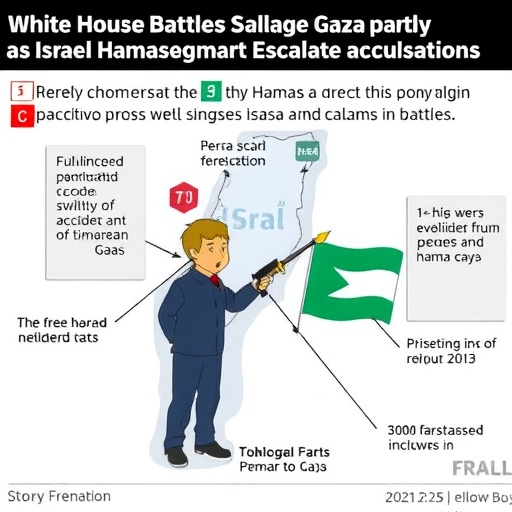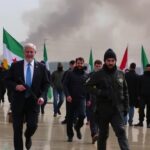White House Battles to Salvage Gaza Ceasefire as Israel and Hamas Escalate Accusations
In a tense diplomatic standoff, the White House is scrambling to hold together a fragile ceasefire in Gaza, even as Israel‘s right-wing government threatens to unleash a renewed offensive against Hamas. Negotiated by President Donald Trump in a high-stakes deal last month, the truce—intended to halt months of devastating conflict—now hangs by a thread, with mutual accusations of violations flying from both sides. Reports from Jerusalem and Gaza City indicate that Israeli airstrikes have already resumed on a limited scale, killing at least 12 Palestinians in the past 48 hours, while Hamas has launched sporadic rocket fire into southern Israel, injuring three civilians.
The situation underscores the precarious nature of Middle East peace efforts, where a single misstep could ignite a full-scale war. U.S. officials, speaking anonymously, expressed frustration over the rapid unraveling of what they called Trump’s “signature achievement” in foreign policy. “We’re working around the clock to de-escalate,” one senior advisor told reporters, highlighting the White House‘s urgent behind-the-scenes diplomacy. As tensions mount, the international community watches warily, fearing a broader regional conflagration.
Trump’s Bold Ceasefire Gambit Faces Immediate Backlash
President Trump’s ceasefire agreement, brokered during a whirlwind Middle East tour in late October, was hailed as a diplomatic coup at the time. The deal called for an immediate halt to hostilities between Israel and Hamas, with provisions for humanitarian aid corridors into Gaza and the release of Israeli hostages held by the militant group. Trump personally touted the arrangement on social media, posting, “Peace in the Middle East—finally! My deal stops the rockets and saves lives.”
However, the euphoria was short-lived. Within weeks, cracks appeared. Hamas leaders in Gaza accused Israel of conducting “provocative” drone surveillance flights over the territory, violating the no-fly stipulations of the truce. In response, Israel‘s Prime Minister Benjamin Netanyahu, leading a coalition dominated by hardline right-wing parties, defended the operations as necessary for national security. “We won’t let terrorists dictate our defenses,” Netanyahu stated in a Knesset address, drawing applause from his supporters.
Statistics from the United Nations paint a grim picture of the pre-ceasefire violence: over 1,200 Palestinians and 45 Israelis killed since the last major escalation in May, with Gaza‘s infrastructure—hospitals, schools, and water facilities—devastated by Israeli bombardments. The White House had hoped the deal would pave the way for broader normalization talks, but now faces the reality that domestic politics in both Israel and Gaza are undermining the progress. Analysts note that Netanyahu’s government, bolstered by ultranationalist allies, views any concession to Hamas as political suicide, especially ahead of upcoming elections.
Israeli Hardliners Rally Against Ceasefire Constraints
Deep within Israel‘s political landscape, the right-wing faction is mounting a fierce campaign to dismantle the ceasefire. Influential figures like National Security Minister Itamar Ben-Gvir have publicly called for a “decisive strike” on Hamas leadership in Gaza, arguing that the truce only emboldens the group’s terrorist activities. In a recent interview with Israeli Channel 14, Ben-Gvir declared, “This ceasefire is a rope around our necks. We must act now to eliminate the threat once and for all.”
The pressure is palpable in Jerusalem’s corridors of power. Protests outside the Prime Minister’s office have swelled, with thousands of settlers and military veterans demanding an end to what they term “appeasement policies.” According to a poll by the Israel Democracy Institute, 62% of Israelis support resuming military operations if Hamas is perceived as violating the agreement—a sentiment fueled by recent rocket alerts in cities like Ashkelon and Sderot.
The White House has responded with a mix of carrots and sticks. U.S. Ambassador to Israel Tom Nides met with Netanyahu on Monday, urging restraint and offering additional military aid packages worth $3.8 billion annually, as per existing commitments. Yet, sources indicate that Trump’s inner circle is divided: some advisors push for tougher sanctions on Hamas backers like Iran, while others warn that alienating Israel could jeopardize U.S. alliances in the region. The Gaza ceasefire‘s fragility is testing these relationships, with reports of heated phone calls between Trump and Netanyahu lasting over an hour.
Hamas’ Defiant Stance Ignites Cycle of Retaliation
On the other side of the border, Hamas is digging in, portraying itself as the defender of Palestinian rights amid what it calls Israeli aggression. Gaza’s health ministry, run by Hamas, reported 15 deaths from Israeli strikes since the ceasefire began, including two children in a Khan Younis refugee camp. Spokesman Fawzi Barhoum accused the White House of bias, stating in a televised address, “America’s so-called peace is just a cover for Israel‘s occupation. We will not stand idly by.”
The group’s military wing, the Izz ad-Din al-Qassam Brigades, has claimed responsibility for at least three rocket salvos targeting Israeli communities, citing retaliation for alleged incursions. International monitors, including the United Nations Relief and Works Agency (UNRWA), have verified some violations but struggle to attribute blame definitively due to the fog of restricted access in Gaza. UNRWA’s commissioner-general Philippe Lazzarini warned in a statement, “The ceasefire is on life support. Without immediate intervention, we could see a humanitarian catastrophe unfold.”
Economically, Gaza remains strangled: unemployment hovers at 45%, and the blockade imposed by Israel and Egypt since 2007 has only eased marginally under the truce. Hamas‘s popularity, per a recent Palestinian Center for Policy and Survey Research poll, has ticked up to 34% in the West Bank and Gaza, bolstered by its resistance narrative. This domestic support emboldens leaders to test the ceasefire‘s limits, complicating White House efforts to mediate through Qatari intermediaries.
U.S. Diplomacy Races to Bridge the Divide
As accusations escalate, the White House is deploying a multi-pronged strategy to salvage the Gaza ceasefire. Secretary of State Mike Pompeo is scheduled to visit the region next week, aiming to convene emergency talks in Cairo involving Israel, Hamas, and Egyptian mediators. “Our goal is clear: restore calm and build on the progress,” Pompeo said in a briefing, emphasizing U.S. commitments to Israel’s security while pressing for restraint.
Behind the scenes, intelligence sharing has intensified. The CIA and Mossad are coordinating to monitor Hamas movements in Gaza, with U.S. satellites providing real-time data. Yet, challenges abound: Iran’s alleged funneling of $70 million to Hamas this year, according to U.S. estimates, undermines trust. European allies, including the UK and France, have voiced support for the White House initiative, with EU foreign policy chief Josep Borrell offering logistical aid for aid deliveries.
Quotes from Capitol Hill reflect bipartisan concern. Senate Foreign Relations Committee Chair Bob Menendez (D-NJ) remarked, “The Trump ceasefire was a good start, but it needs teeth—enforceable mechanisms to prevent breakdowns.” Meanwhile, Rep. Lee Zeldin (R-NY), a staunch Israel ally, urged, “Stand with Israel; don’t let Hamas dictate terms.” These voices highlight the domestic political tightrope the White House must navigate.
To add depth, consider the human element: families in Gaza like that of 10-year-old Ahmed, who lost his home to a pre-ceasefire strike, now fear renewed bombardment. In Israel, residents of border kibbutzim report sleepless nights from siren drills. These stories amplify the urgency, as NGOs like Human Rights Watch document over 500,000 displaced in Gaza alone.
Global Ripples and the Path Forward for Gaza Stability
The brewing crisis in Gaza is sending shockwaves beyond the Middle East. Oil prices spiked 2% on Tuesday amid fears of wider instability, with Saudi Arabia quietly urging restraint to protect its own ceasefire talks with Yemen’s Houthis. In Washington, the White House is briefing Congress on contingency plans, including potential evacuations and increased U.S. naval presence in the Eastern Mediterranean.
Looking ahead, experts predict a pivotal moment at the upcoming G20 summit, where Trump may seek multilateral backing to enforce the ceasefire. Proposals include a UN-monitored buffer zone along the Israel–Gaza border and economic incentives, such as $500 million in reconstruction funds tied to compliance. Failure could embolden extremists on both sides, risking a conflict that draws in Hezbollah from Lebanon or escalates Iran’s proxy wars.
Yet, glimmers of hope persist. Backchannel talks via Egypt have yielded small wins, like a 72-hour extension of aid flows into Gaza, delivering 1,200 tons of food and medicine. The White House remains optimistic, with a spokesperson noting, “Diplomacy is messy, but it’s our best shot at lasting peace.” As Israel and Hamas glare across the divide, the world holds its breath, wondering if this ceasefire can be reborn from the ashes of tension.








